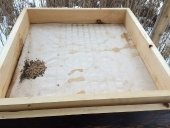
 5
5




 </script>
</script>
 </script>
</script>My project thread
Agriculture collects solar energy two-dimensionally; but silviculture collects it three dimensionally.




Iterations are fine, we don't have to be perfect
My 2nd Location:Florida HardinessZone:10 AHS:10 GDD:8500 Rainfall:2in/mth winter, 8in/mth summer, Soil:Sand pH8 Flat




My project thread
Agriculture collects solar energy two-dimensionally; but silviculture collects it three dimensionally.




 1
1




Check out Redhawk's soil series: https://permies.com/wiki/redhawk-soil




Best luck: satisfaction
Greatest curse, greed




www.yardenofeden.org
Where Philosophy meets the Farm: an approach to sustainable living.
 1
1




Check out Redhawk's soil series: https://permies.com/wiki/redhawk-soil
 1
1




Permaculture Designer
Natural Builder
Crazy fire builder
James @ KniskernKnoll
https://www.facebook.com/james.kniskern
https://www.facebook.com/KniskernKnoll




Best luck: satisfaction
Greatest curse, greed




J Dog wrote:CJ,
Try soaking those logs (pond, bucket, water trough) for about 5-6 hrs. Then re-stack them. Should start growing.
My project thread
Agriculture collects solar energy two-dimensionally; but silviculture collects it three dimensionally.




Thekla McDaniels wrote:If I were to try this, what temperature range would the oyster mushrooms prefer?
My project thread
Agriculture collects solar energy two-dimensionally; but silviculture collects it three dimensionally.




John Saltveit wrote:Tree oysters are native here, as they are in many places. We are rarely below freezing in the winter for very long. Rarely for 24 hours in a row, but very consistently wet, and we have huge forests, so lots of wood. They can definitely tolerate moderate cold, depending on the type of oyster. There are many species.
John S
PDX OR
My project thread
Agriculture collects solar energy two-dimensionally; but silviculture collects it three dimensionally.




Cindy Ruprecht
 1
1




Check out Redhawk's soil series: https://permies.com/wiki/redhawk-soil
 1
1





www.yardenofeden.org
Where Philosophy meets the Farm: an approach to sustainable living.




My project thread
Agriculture collects solar energy two-dimensionally; but silviculture collects it three dimensionally.




Best luck: satisfaction
Greatest curse, greed












My project thread
Agriculture collects solar energy two-dimensionally; but silviculture collects it three dimensionally.




www.yardenofeden.org
Where Philosophy meets the Farm: an approach to sustainable living.




www.yardenofeden.org
Where Philosophy meets the Farm: an approach to sustainable living.




Thekla McDaniels wrote:Well, here is a thought about what to do about the problem of too much water in the bottom of the food grade plastic buckets we are all so familiar with (if that IS a problem).... Couldn't you install a little plastic spigot of some kind, like the one at the bottom of worm bins, to extract the "tea"? Or if those are not as easy to find as I think, then the plastic fittings that are used to drain swamp coolers?
My project thread
Agriculture collects solar energy two-dimensionally; but silviculture collects it three dimensionally.




Check out Redhawk's soil series: https://permies.com/wiki/redhawk-soil








Check out Redhawk's soil series: https://permies.com/wiki/redhawk-soil








Casey Williams wrote:
Do I have to boil the wood chips, or could I possibly cold ferment them as well? How long do you boil the wood chips for?
My project thread
Agriculture collects solar energy two-dimensionally; but silviculture collects it three dimensionally.




 1
1








My project thread
Agriculture collects solar energy two-dimensionally; but silviculture collects it three dimensionally.




Regan Dixon wrote:Question for CJ Sloane about the chips from chainsawing: any concern about the chain oil that's on the chips?






 1
1




My project thread
Agriculture collects solar energy two-dimensionally; but silviculture collects it three dimensionally.




Every year thousands of gallons of chain-and-bar oil are carried into the forests and none returns.
My project thread
Agriculture collects solar energy two-dimensionally; but silviculture collects it three dimensionally.
 1
1




Regan Dixon wrote:Ah, food grade oil. I didn't know that would work? I learn something new every time I'm on this forum!
Question for Peter Ellis: my presumably petroleum-based chain oil is marked "harmful or fatal if swallowed". So, I'm curious to know whether oyster mushrooms break down the oil into smaller chains of non-toxic compounds, or whether they would sequester any heavy metals that might be present in the oil? Yes, some fungi do take up heavy metals, as do some plants and trees, which is why I understand they are used in environmental remediation--to get the metals out of the ground and water--but I don't believe that renders those metals edible. I also don't know what specifically is in the chain oil that makes it toxic. Off to look that up....










Medicinal herbs, kitchen herbs, perennial edibles and berries: https://mountainherbs.net/ grown in the Blue Mountains, Australia

|
I guess I've been abducted by space aliens. So unprofessional. They tried to probe me with this tiny ad:
Support permies and give beautiful gifts to gardeners: permaculture playing cards.
https://gardener-gift.com/
|









